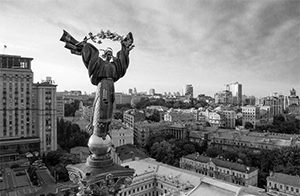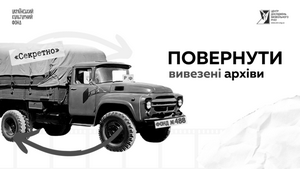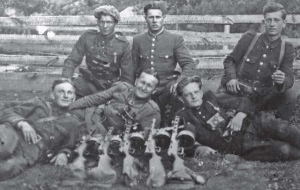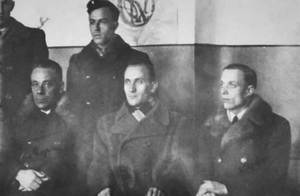Which Petliura Does His “Secret Diary’’ Depict? An Impression of a Historian
Fresh Impressions of the good, and what’s more important, the needed film, and some points of criticisms are, maybe, acute, but have only the aim to make the Ukrainian cinema better.
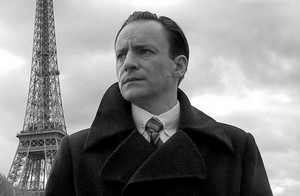
A Ukrainian movie "The Secret Diary of Symon Petliura" was released recently.
An event for our country is significant and long-awaited, because in fact it is the first complete film, since Ukraine has become independent, entirely dedicated to one of the leaders of the Ukrainian revolution — Symon Vasyliovych Petliura.
As the head of the Directory and Commander-in-Chief of the armed forces, he ruled the Ukrainian People's Republic (UNR) in 1919—1920, during the most difficult period of its existence, and then, until his tragic death in May 1926, headed the State Centre of the UNR in exile.
Petliura has become a true symbol of struggle for freedom and independence of Ukraine. Even his name has become universal and meaningful. The enemies called the Ukrainian soldiers "Petliurites", and the latter used this name with a great honour.
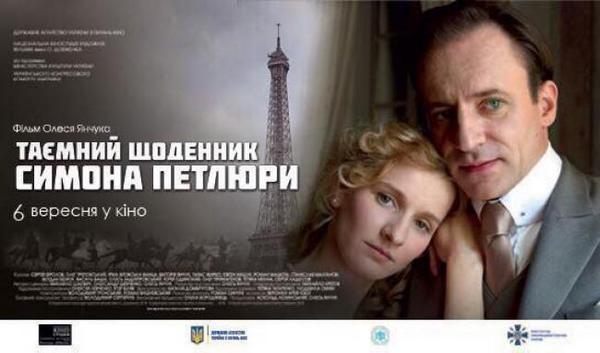 |
| "The Secret Diary of Symon Petliura" Poster |
This film is quite actual according to current social-political realities of modern Ukraine.
It has been needed for a long time, so it is now, because with the help an accessible cinema language tells the audience about one of the pillars of the Ukrainian Revolution.
We also have to note that due to our love for the "round" dates the picture also came out very timely. The next year will be the 140th anniversary of Symon Petliura's birthday.
The plot of the film is based on the principle of a diary, which Petliura supposedly writes himself. And although there is no such real diary, at the same time, we cannot deny that Petliura could have an intention of writing it. So this form of submission of the material is quite acceptable.
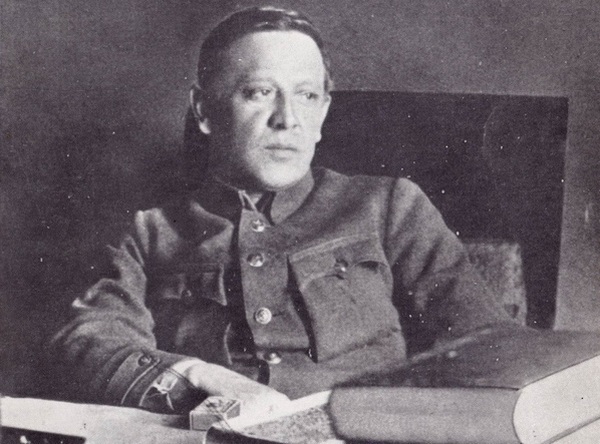 |
| Real Symon Petliura at the desk |
Excuse me, but "professional deformation" was made itself felt, so I just did not get a chance to watch the movie as a regular viewer — the historian's eye noticed small and big mistakes, inappropriateness and fails that are present in any cinema work.
I ask you to accept the following remarks not as fault-finding, but as constructive criticism, because the film was generally acceptable.
The authors focus on some key episodes of the life of the Ukrainian leader. Thematically the film is clearly divided into two parts.
The first one covers the period 1917—1920. The second — tells about the last years of Petliura's life, his tragic death and the trial of his murderer. If the last does not give special reasons for excessive criticism, then the first, unfortunately, gives a wide field for acute comments.
At the beginning of the movie, there is an episode where the Ukrainian troops, defeated in the battle against the "reds", at the end of November 1920 retreat to the western bank of the Zbruch river and surrender their weapons to the Poles. Despite the apparent tragedy of the situation, the episode turned out to be absolutely "flat" and unmotivated.
The soldiers walk in a file and calmly throw their rifles on a pile. At the same time, for some reason, the Poles are not behind the bridge, but in front of it, that is, on the Ukrainian territory.
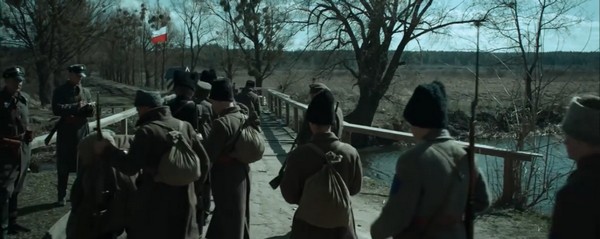 |
|
UNR Army Cossacks retreat to the Polish territory. A screenshot |
In fact, the UNR Army retreated in an orderly manner, with heavy battles, holding the Volochysk bridgehead to the bitter end and giving the opportunity to as many military, civilian refugees, transports, property, etc as possible to reach the opposite bank.
There is a lot of memories of the regular armed struggle participants about its final moment; it is described well in professional literature and even in poetry. Let's recall here a poem by Yevgen Malaniuk.
Those days could be never forgotten:
We were leaving the last piece of land.
Circles trembled and were frightened
By tired thunder of cannons.
Ominous birds were flying over
They were pursuing sorrowful march.
And the train sobbed: To the West ...To the West ... To the West
And then — the East roared with laughter.
It gaped its bloody jaws.
The drunken breath made sick like death.
Where could we find better than You
by our hearts full of You to the brim?
Unfortunately, there was no thunder of guns, no rumbling of echelons, no sinister birds, nor emotional experiences of soldiers in this scene (the scene with the sabre wrecking was too picturesque).
And the very procedure of the weapons handover was in fact different — without ostentatious, as in the film, humiliation of Ukrainian soldiers by the Poles. The Poles treated their former allies with great respect.
The next episode.
December 1917, there is a meeting of the Government of the UNR, for which there are for some reason only 4 people — Grushevsky, Vynnychenko, Petliura and a stout stenographer, it seems, Mrs. Olia.
The question arises immediately: where are the other government members, why are they not at the meeting?
Petliura reports on the situation in Kyiv and speaks of the necessity of suppressing Bolshevik activity.
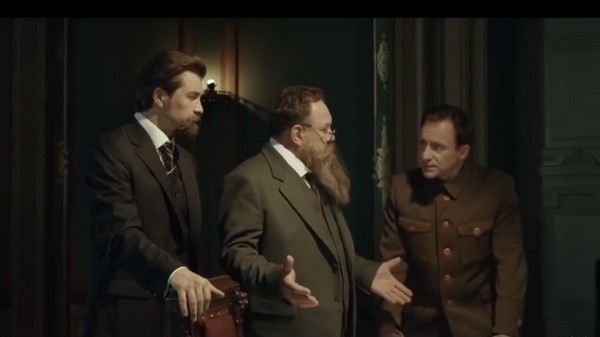 |
|
Yevgen Nyshchuk acting the Head of the General Secretariat Volodymyr Vynnychenko, Bogdan Beniuk acting Cental Rada Chairman Mykhailo Grushevsky and Sergiy Frolov acting Symon Petliura. A screenshot |
Then the assault on "Arsenal" happens, but the authors do not indicate that it is already 1918, the end of January, Old Style, or the beginning of February, New Style. And the main thing — that Petliura at that time has no longer been in government, but instead leads the Haidamaka volunteers who under his command, in the end, conquer the "Arsenal".
The Petliura’s story lacks his conflict with Vynnychenko, his dismissal ofrom the secretary general for military affairs position and formation of the Haidamaka Unit of Sloboda Ukraine. From these events one could make very advantageous scenes, which would place Petliura in good light: although he was fired unfairly, he did not fall in despair and continued to fight.
After the successful assault on "Arsenal", Petliura comes to the captured rebels, among whom Yevgenia Bosh is introduced to him as "she is in charge here." Petliura orders to send everyone to Lukyanivska prison.
The scene undermines the Soviet myth of 300 massacred with bayonets rebels. But what does Yevgenia Bosh have to do here? She did not lead the factory uprising, and therefore did not fall into captivity.
Something is wrong with the chronology in an episode with Colonel Petro Bolbocean. At first, Petliura meets with him and sends to Italy (it was in May 1919), and then Bolbocean talks with Warlord Volokh, as the caption reads, in February 1919 in Kyiv in the "Continental" Hotel.
In the scene where death sentence is announced not the original document is read (it is well-known and published, no need to search for it deliberately), but some completely modern "loosely based" work. Then a strange scene of the execution.
Why do the authors of the film think that the Cossacks of the firing-squad refused to execute the sentence? Eyewitnesses point out that the head of the counterintelligence Khorunzhy [Leutenant — ed. note] Chebotariv, committed supporter of Petliura, in order to avoid any surprises, replaced the soldiers who guarded Bolbocean at the last moment with reliable men.
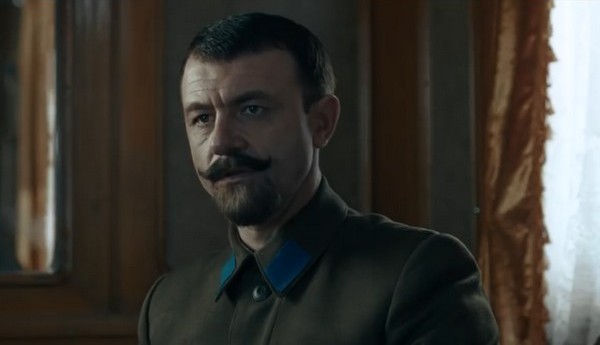 |
| Cinema Colonel Bolbocean. A screenshot |
And Bolbocean's death was not as heroic as it was shown in the film. Again, eyewitnesses claim that he was already "dead spiritually and physically, he was scalded in the soul and body." After the salvo, he fell to his knees and was finished by rifle butts. The colonel’s last words allegedly were: "My little daughter, save me!".
Next is an absolutely fantastic episode. Petliura somewhere commands defense of an infantry unit that holds positions in trenches, and repels a mounted attack of a "Red" cavalry unit.
Since the soldiers have triangular colored flaps on their coats to denote the ranks imposed by the order in late April 1919, and there is apparently not summer weather in the street, we conclude that this should be the end of the fall of 1919, the time of the catastrophic defeat of the UNR Army.
What was the combat that Petliura led personally is, unfortunately, unknown. Petliura as the commander-in-chief certainly attended positions of troops at the front, but such cases of taking direct part in the battle on the front edge are unknown and could hardly have taken place at all. The function of the commander-in-chief is entirely different.
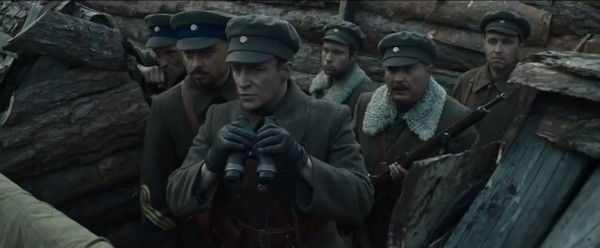 |
| Petliura in person commands a defence of an unknown unit. A screenshot |
This episode shows a close-up of the Ukrainian Cossacks wearing Adrian helmets, on which, for some reason, still two-headed imperial eagle, and not a Ukrainian tridents, are painted. This is another inappropriate fail, because it is well-known (there are original items and photographs) that instead of the Russian emblem, the soldiers fixed Ukrainian cockades or, in their absence, simply painted a trident.
The chronology is, again, confused, because in the next scene Petliura accidentally meets general "Krevs" (so is in the film, although there must be Kraus), and he in turn sees the Russian general Bredov in Kyiv.
So here the events take place at late August — early September 1919. Maybe these are Petliura's thoughts that leap when he mentions the events for his diary, but for ordinary viewers who are not familiar with the details of the history of Ukraine all this must be explained and presented consistently.
"Krevs" tells Petliura about Bredov, that he has remembered him since the First World War, when he led the 4th Grenadier Division! Here we have a childish mistake — there was no "4th Grenadier Division" in the Russian Army (there were three number divisions and one Caucasian without a number), and Bredov led entirely other units and institutions. Here too, Wikipedia would be enough to avoid such a mistake.
Further, Bredov calls "Krevs" an Austrian general, but in the Imperial and Royal Army, he rose to the rank of a lieutenant colonel, and became general in the Galician Army — again a childish mistake, from which the same Wikipedia could easily save.
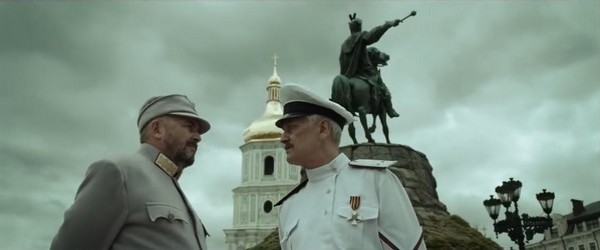 |
|
That very scene on Sofiyisvka Square in Kyiv where generals Kraus-"Krevs" and Bredov meet. A screenshot |
The scene of Petliura's meeting with Piłsudski looks strange, while Piłsudski was captioned as the Head of the Polish government, although he was not the prime minister, but the "Chief (Leader) of the Polish state" (again an obvious Wikipedia-level error!).
This is a very important remark, because there were equal leaders of two sovereign states who reached the principle political agreement on allied actions.
In the film, during a conversation, Marshal Piłsudski suddenly puts his hand on Petliura's shoulder, speaks on intimate terms with him as an old friend, and it seems that he is going to say: "Look here, chap."
This is absolutely inappropriate and intolerable familiarity in communication between two statesmen. It humiliates Petliura and is unbecoming of Piłsudski (if seriously, Piłsudski allowed to be on intimate terms only with his two most faithful old friends).
Piłsudski’s Marshal coat comes as surprise. The main blame here is — why there are no crossed maces on the Marshal’s shoulder boards of the Polish leader? Were they forgotten?! Another shocking and obvious error that could be easily avoided by consulting Wikipedia.
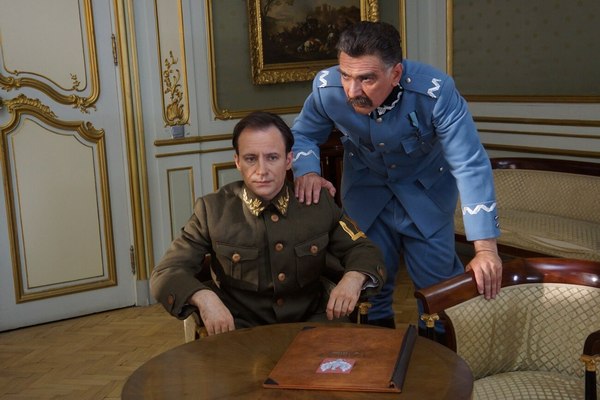 |
| Two statesmen are depicted as old buddies in the film. And Józef Piłsudski lacks maces on his shoulder boards. A screenshot |
After Petliura agreed with Piłsudski, in early spring he traveled somewhere and in the field met a Ukrainian Galician Army soldier, a Galician peasant, who reproached him for his agreement with the Poles.
That peasant’s role is acted by the former MP Mykhailo Ratushny (acted, by the way, quite naturally). He introduces himself to the Supreme Ataman the same way, saying that he himself is Ratushny and everybody’s surname around here is aslo Ratushny.
In order to complete the picture and localize the terrain, the audience should be informed that it was the Chernikhivtsi village of Zbarazh county in Ternopil region, where Mr. Ratushny comes from.
Then Petliura’s car, which moves alone without a clear purpose for the viewer somewhere along the field road, is suddenly attacked by the "Red" cavalry patrol.
Petliura’s adjutant is killed in a shootout, the Supreme Ataman himself and the driver fire the rifles and defeat the enemy, who also has losses.
The scenes both with peasant and shootout, are complete fiction and fantasy of the film's authors. In spring 1920, Petliura was in Warsaw. To the temporary capital of the UNR, Kamyanets-Podilsky, he arrived on May, 1 by train!
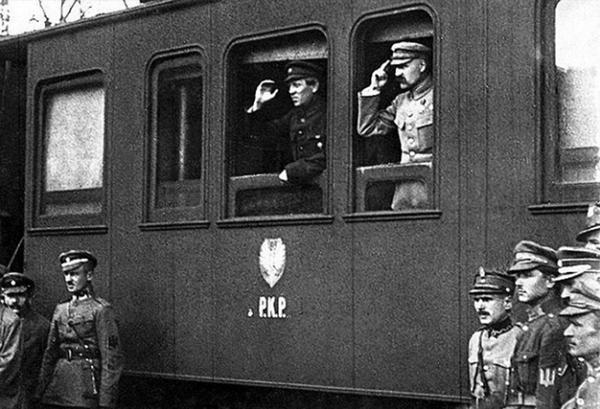 |
|
Symon Petliura and Józef Piłsudski in Vinnytsia, 1920 |
This fact is known, there are many photos from the meeting of this statesman at the train station. There were not and could not be at all any car rides through occupied by Poles Galicia, especially with shootouts.
And in general, these Petliura's car journeys are very weird. Through fields and woods drives the head of the state and commander-in-chief his car with only an adjutant on their way encountering either corps commander General "Krevs" (who also travels alone), or the peasant Ratushny, or the enemy horsemen…
In one episode Petliura recalls the "second march to Ukraine".
What exactly the Supreme Ataman means, we learn, when in the next scene we see Kotovsky, who receives "an order to eliminate the Tiutiunnyk's gang" (by the way, Tiutiunnyk himself is abscent in the movie).
So it is clear that this is the 2nd Winter March or the November Raid of 1921. However, it is unclear why the script writer expelled the word "Winter" (maybe it seemed to him superfluous), but here it is decisive, that clearly points to a particular historical event.
"2nd March in Ukraine" can be considered anything, depending on what sense we put into the word "march" and what reference point take in counting them.
Such "Second march" may be, for example, the summer offensive of Ukrainian troops at Kyiv in 1919 or the joint Polish-Ukrainian advance in spring 1920. At first glance — a simple trifle (say, just one word is missing), but in reality — it turned out to be another important and misleading error.
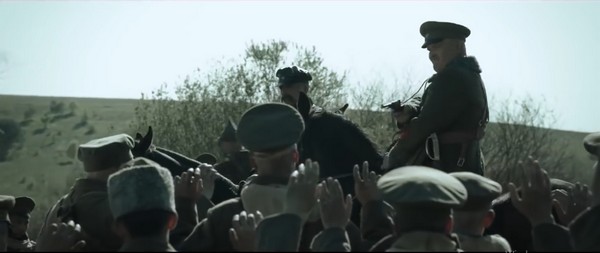 |
|
The execution scene of the UNR Army soldiers near Bazar happens in spring although really it took place in November 1921 when snow covered the land. A screenshot |
We must say that the authors of the film successfully, very brightly, boldly, with deep emotions showed the Bazar tragedy — the merciless execution of 359 insurgents who refused to turn to the side of "Reds".
To be frank, it would be much better if they did not shoot these scenes in the early spring with fresh green on the trees (it is very striking), but around the late autumn and necessarily with snow cover, as it was in fact in November 1921.
Again, a trifle and again neglecting historical facts, which negatively affects the general perception of the film.
Another scene of the film is not entirely consistent with historical realities. This is the conversation of Petliura with Warlord Semesenko after he in February 1919 conducted bloody Jewish pogrom in the town of Proskuriv.
Responding the Supreme Ataman’s blames Semesenko sharply answers: "I am the combatant officer!" The author of the dialogs obviously did not know that there were no "officers" in the Ukrainian Republican Army (this word had only negative connotation and was perceived as legacy of the tsarist regime), but instead were "starshynas" (according to the traditions of the Cossack army).
And the very provoking behavior of Semesenko during the talk and his subsequent arrest contrasts sharply with his tearful and obedient letters in which he begged Petliura for mercy.
For the sake of objectivity we must add that the arrest did not took place immediately after the massacre, but only three months later, in May 1919, and Semesenko was sentenced not for the massacre of civilians, but for other crimes — disobedience, misappropriation of the warlord title, troop train confiscation and threating of violence to government officials.
The authors could convince the audience that Petliura fought against Jewish pogroms without violating the historical truth.
The Supreme Ataman could be shown as he writes / edits / signs his real orders on preventing pogroms.
It could be possible to show as he rejects requests of the condemned pogrom-makers for pardon; as Petliura is present at the executions of soldiers who committed robberies and massacres of Jews; as he allocates financial assistance to the Jewish victims; as he meets representatives of the Jewish community of Kamyanets-Podilsky in July 1919, during which Petliura declared his determination to fight pogroms firmly, and his vis-a-vis — their readiness to defend the UNR together with Ukrainians.
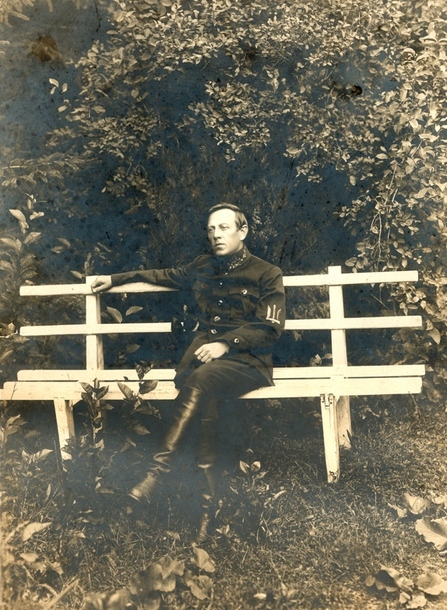 |
|
Head of the Directory Symon Petliura in the town of Kamyanets-Podilsky, 1919 |
French journalist Jean Pelisie appears periodically throughout the film.
For example, we see him next to Petliura during the entry of the troops of the Directory of the UNR in Kyiv in December 1918, as well as in trenches during barrage in the battle, which Petliura personally led (as we had established earlier in autumn 1919).
At the same time, the French journalist shoots everything that is happening before his very eyes by his camera, trying to save historical events for descendants.
Thus, the original Ukrainian newsreel, which has been saved until our time is intertwined with the structure of the film.
At the end of the film, Petliura meets Pelisie in Paris, and the latter tells the Supreme Ataman that he had shot a lot, but the enemies of Ukraine had spoiled most of the films during his return home, thinking that he had been carrying gold and jewels in boxes.
Petliura in fact did maintain friendly relations with the French journalist Jean Pelisie, who was a true friend of Ukraine. They often met at the end of 1917 — early 1918, but then did not see each other for a long time.
So Petliura wrote about it in the letter of October 28, 1919:
"It's been a long time since I've seen you. Since then, we have experienced a lot of difficult moments, and not a single gray hair points to those painful milestones of the road we went."
Episodes which show the life of Symon Petliura and members of his family: the wife Olga and daughter Lesia in Paris deserve special attention.
The family lives a prosperous life — Petliura is dressed fairly well, so do his wife and daughter.
They always wear expensive dresses with hats (and often change them), look well-groomed, have beautiful hairstyles, expensive jewelry (both wear pearl necklaces, earrings etc.).
It is obvious to the viewer that the family is by no means in need, they do not feel any trouble, live in rooms with phones, have extra money, which spend on dinners in expensive restaurants.
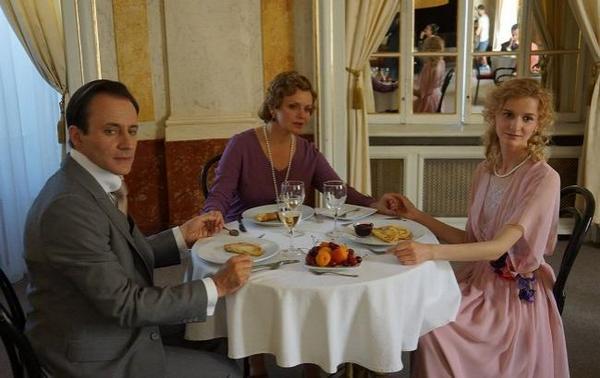 |
| The Petliuras on screen appear to be rather wealthy although in fact they lived "from hand to mouth." A screenshot |
But this is absolutely not the case! Petliura, in his own words, lived in Paris "from hand to mouth." The people who saw him then in the French capital emphasized that he "lived poor."
For that humble means that he received irregularly from the UNR State Center in emigration or from other sources, Petliura rented a very modest dwelling — his last apartment was located under roof and had two small rooms with a minimum set of the most necessary furniture and without a telephone.
He did not have kitchen, so he had meals at cheap restaurants in the neighborhood. He spent his humble allowance on cigarettes (he smoked up to 40 cigarettes a day), newspapers and books.
His wife Olga and daughter Lesia lived as poorly as Petliura. The wife made a living doing embroidery to pay her daughter's studies in the French Lyceum (parents paid much attention to Lesia’s education and did not grudge money).
All the jewelry had been sold long time before they arrived in Paris.
Such circumstances did not encourage to think about jewelry, peignoirs and hairstyles.
Photos of Petliura’s wife and daughter were preserved. Their look is more than modest. On one picture, mother and daughter wear dresses made of the same material; no jewelry, no pearls.
Women’s hairstyles are another story. Lesia Petliura had dark hair plaited in two typical girl pigtails, and Olga Petliura had already gray hair, just gathered in "bun".
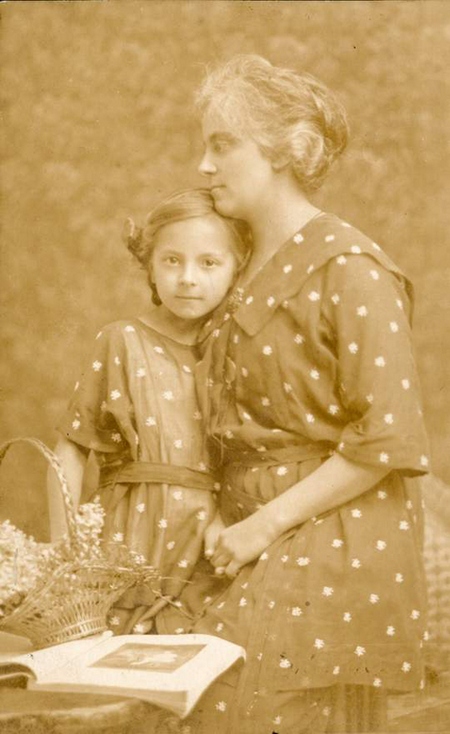 |
|
Symon Petliura's wife Olga with their little daughter Lesia both wearing dresses from the same material |
Beyond all the emotional experience, hard work and child care she had no time to do any special hairstyles.
Consequently, we have a distorted image of the Supreme Ataman and members of his family, which demonstrates in every way the "modest charm of the bourgeoisie" on the screen.
Probably, the film-makers were influenced by the established stereotype of Paris as the capital of world fashion, beauty, a city of carefree lifestyle and love.
The choice of the actress for the role of Lesia Petliura was extremely unsuccessful.
It should be a modest dark-haired girl of 14.5 years with pigtails, who loves dogs and cats very much, collects stamps, takes an interest in drawing, writes poetry, loves her parents to distraction, and is extremely worried about the death of her beloved father and the subsequent legal proceedings.
As a result of stress tuberculosis began to develop at her (this disease had not yet been treated well), which actually broke the life of Lesia Petliura at the age of 30 years, preventing her talents from being fully unlocked.
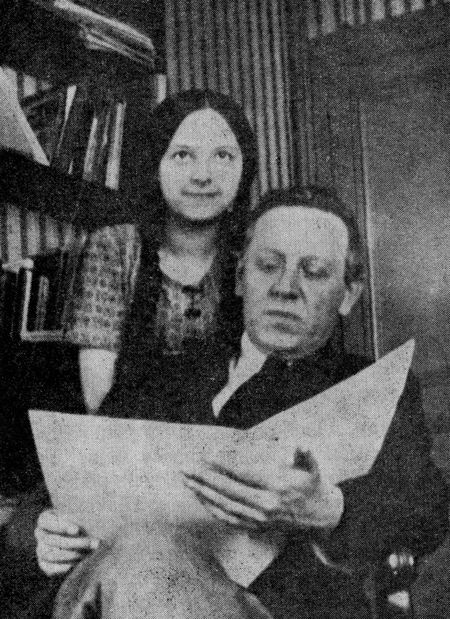 |
| Lesia Petliura with her father, autumn 1925, Paris |
Instead, in the movie we see a pretty girl 10 years older than her character with blonde curles, absolutely static, who without any emotions, any manifestations of inner experience expresses dull, short and banal phrases.
So, the authors of the film selecting the actress for this role, absolutely (that is, at all) ignored the type of real Lesia Petliura, and did not even consider her age.
Ask why? The answer is obvious — because this was the daughter of the principle director, who, apparently, itched to star the main role, play the daughter of Petliura and see herself on the posters!
Of course, the director has full right to give his daughter a role in the film as an actress, but unfortunately, not in this case, when she had to play a real historical figure, the daughter of the main character of the picture.
Separately, one should dwell on the key figure of the whole movie — Symon Vasyliovych Petliura.
He was performed well by an actor Sergiy Frolov, who quite resembled his character. But the dress let down as usual.
Traditionally, there was too much "Paris chic", and the hats on the actor were clearly too big for him, so they looked very ridiculous when pulled deep over his ears.
However, this was not the main thing.
In the film, Petliura tangibly lacks positive. Except seizure of the "Arsenal" — no other victory is shown.
Instead of fictitious episodes, the real moments of triumph and glory that the Supreme Ataman experienced indeed, for example:
- Petliura and his Haidamakas entering Kyiv liberated from the Bolsheviks in March 1918 (this would greatly undermine the established myth that the Germans were the first to enter the city);
- the entrance of the Directory to Kyiv in December 1918 after the Hetman Skoropadsky fled abroad;
- the solemn proclamation of the Act of Unification in January 1919 on Sofiyifska Square;
- the offensive of the Ukrainian forces in late summer of 1919;
- the Ukrainian troops parading before their commander-in-chief in Kyiv in May 1920.
Instead, in the film Petliura constantly grieves and repents, grieves and repents, with eternal gloom in his eyes.
Such pessimism does not correspond to the temper of real Petliura.
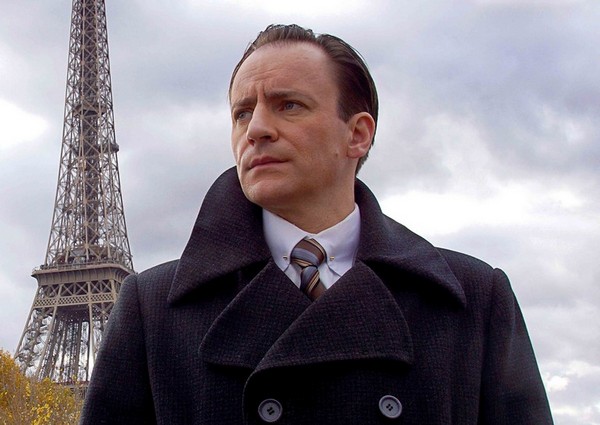 |
|
The actor Sergiy Frolov performing Symon Petliura in emigration |
Memorialists unanimously recall that, despite the most tragic situation at the frontline, Petliura always produced cheerful impression on everybody, inspired with confidence and optimism, raised the faith, and gave hope.
For example, in the "Death Triangle" at the end of November 1919, when the Ukrainian army was in a catastrophic situation surrounded by enemies, Petliura addressed to the soldiers:
"Looking at all you here, I remember and recognize not a single name and face of those people with whom I was lucky to start the work and struggle for freedom of Ukraine.
In the difficult situation in which the Ukrainian army at this moment is, some might think, whether it is time to lose heart.
There is no bigger mistake than to think that way.
Have we achieved anything for Ukraine with our struggle? Our struggle will be recorded in golden letters to the history of the Ukrainian people.
We entered the arena of history when the whole world did not know what Ukraine was. Nobody wanted to recognize it as an independent state, nobody considered our people as a separate nation.
Only with struggle, stubborn and uncompromising, showed we the world that Ukraine exists, that its people lives and fights for its right, for its freedom and state independence!
Those who undervalued our movement now see that we are the force that should be taken into consideration ... Let us recognize without pride and without extra modesty that during our ... struggle we have created the Ukrainian nation that will continue active fight for its rights, for its right to rule its land on its own and independently from anyone!"
Such Petliura’s fiery words inspired the soldiers who soon went to the First Winter March through the hinterland of the "Whites" and "Reds", and saved the core of the army for the next stage of the struggle.
How is this episode shown in the movie? There is a column of soldiers marching somewhere, Petliura meets them and asks about Warlord Volokh. Petliura is told that he robbed the State Treasury and turned to the Bolsheviks. Petliura orders the soldiers to move in another direction, to catch Volokh. That is all.
The episode with lack of dynamics that gives little to the viewer and raises additional questions about who that Volokh was and why he had robbed the treasury.
A meeting with commanders, instead, discussion over a catastrophic situation and search for a solution on the eve of the First Winter March, which saved the army from the final defeat, would have had much greater effect.
Petliura left a great journalistic and epistolary heritage. Today, 5 volumes of documents, letters and articles written by him have already been published. The authors of the film could, relying on original works, capture Petliura’s style and make the actor's language as close to the language of the Supreme Ataman as possible.
In other words, the screen Petliura could speak the language of Petliura real. In the film, his speech is very modern, according to the literary norm of the beginning of the XXI century. His speech is devoid of any individual feature of the historical character played by the actor.
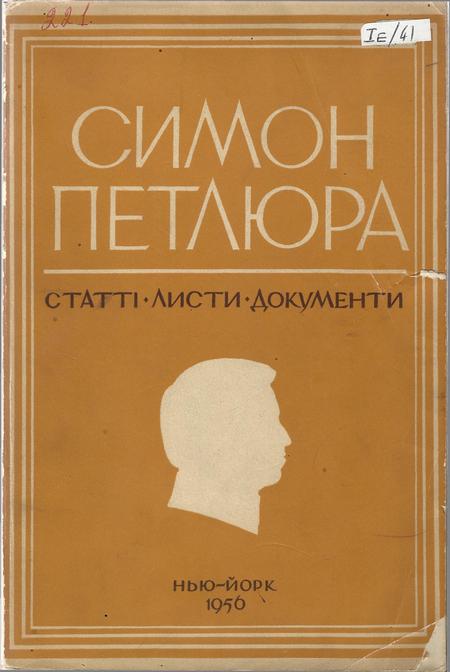 |
| The first volume of Symon Petliura's writings from London OUN Archives |
In addition, constant sorrow and tragedy, radiated by the actor, brings the viewer to the false thought that Petliura was disappointed, lost his heart, and was in despair.
However, this was not true. Unlike the other leaders of the Ukrainian revolution, Grushevsky and Vynnychenko shown in the film, Petliura, in spite of the defeat and difficult conditions of emigrant life, did not abstain from active politics, continuing to work actively and tirelessly for the Ukrainian cause.
Here's what Petliura wrote then. For example, November 1, 1925:
"Only the organized and not scattered prevail. This truth, justified by age-old experience, should also become our guide and memento in a foreign land.
We must especially feel the significance of the organization in front of the challenges facing us, and in a foreign land in particular, as part of a nation that has begun to organize its forces for the achievement of the state ideal.
We cannot achieve them being atomized, disjunct, but only united together, connected by unity of effort and subordinated to the highest requirements of the national cause."
Or — January 22, 1926:
"Let us not forget about the sword; let us learn to hold it harder in our hands, and at the same time let us care about nurturing the nation with the moral elements of its existence — creative love for the homeland, awareness to the enemy and revenge for injustices caused by him — in the symbiosis of which we will find the true way to liberation and a programme for building!"
April 18, 1926:
"There is the government of the UNR led by Symon Petliura abroad. But even rid of its territory, this government does not stop the struggle for the liberation of Ukraine."
"Yes, only facing the West! Only the national, independent from anybody Ukrainian state! We profess this firmly and unwavering. For this we fought, fight and will fight to the end. And in this struggle for the liberation of our Motherland, for the restoration of human life in Ukraine, for the restoration of our statehood, we, who lead that work abroad, are given great moral assistance by realizing that the conscious sons of their nation, there on the conquered Motherland, think the same way and strive for the same."
Agree, these words of Petliura have not lost their relevance for us even today! They could be a perfect end for the entire film, becoming a "bridge" that would connect Petliura with modern independent Ukraine (one phrase in the credits that Ukraine gained independence 65 years after the death of the Supreme Ataman is not enough).
The disillusioned and mournful Petliura, who abandoned his cause, was by no means dangerous for the Kremlin.
Instead, Petliura, who had not surrendered his weapons, who radiated steadfast faith who inspired for the continuation of struggle, whom Ukrainians listened to and obeyed not only in emigration, but also in the enslaved homeland — such Petliura was dangerous for the Bolsheviks.
Such Petliura — a fighter, not a whimperer — was assassinated in Paris in May 1926. Such Petliura do we also need today.
